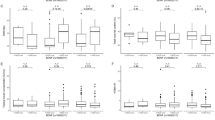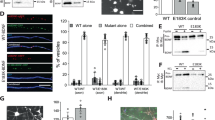Abstract
Several lines of evidence support a role for brain-derived neurotrophic factor (BDNF) alterations in the etiology of eating disorders (EDs). BDNF heterozygous knockout mice show alterations in eating behavior, increased body weight and adipocyte hypertrophy. BDNF also regulates the synaptic efficiency through the modulation of key neurotransmitter systems previously known to be involved in ED. These findings, together with the fact that this neurotrophin is expressed in the hypothalamus nuclei associated with weight regulation and feeding control, led us to propose BDNF as a candidate gene for ED. To investigate the possible involvement of this neurotrophin in eating behavior, we screened the BDNF gene in 95 ED patients and identified four sequence variants. Two of them, −374A/T and −256G/A, were found in two patients with anorexia nervosa (AN) and consisted of single-nucleotide mutations within the 5′ untranslated region (5′UTR). The other two polymorphisms resulted in a C to T transition located at the 5′UTR of the BDNF gene and an amino-acid substitution within the BDNF precursor protein (Val66Met). We performed a case–control study for these two Single-nucleotide polymorphisms in a sample of 143 ED patients and 112 unrelated controls and found a strong association of restricting AN (ANR) with the Met allele of the Val66Met BDNF polymorphism (2p=0.002). There was also evidence for a significant effect of this sequence variant on the minimum body mass index (MBMI) (2p=0.006). These results suggest that the BDNF Met66 variant may be a susceptibility factor to ED, mainly to ANR and low MBMI.
This is a preview of subscription content, access via your institution
Access options
Subscribe to this journal
Receive 12 print issues and online access
$259.00 per year
only $21.58 per issue
Buy this article
- Purchase on Springer Link
- Instant access to full article PDF
Prices may be subject to local taxes which are calculated during checkout

Similar content being viewed by others
References
Kernie SG, Liebl DJ, Parada LF . BDNF regulates eating behavior and locomotor activity in mice. EMBO J 2000; 19: 1290–1300.
Knusel B, Winslow JW, Rosenthal A, Burton LE, Seid DP, Nikolics K et al. Promotion of central cholinergic and dopaminergic neuron differentiation by brain-derived neurotrophic factor but not neurotrophin 3. Proc Natl Acad Sci USA 1991; 88: 961–965.
Mamounas LA, Blue ME, Siuciak JA, Altar CA . Brain-derived neurotrophic factor promotes the survival and sprouting of serotonergic axons in rat brain. J Neurosci 1995; 15: 7929–7239.
Mossner R, Daniel S, Albert D, Heils A, Okladnova O, Schmitt A et al. Serotonin transporter function is modulated by brain-derived neurotrophic factor (BDNF) but not nerve growth factor (NGF). Neurochem Int 2000; 36: 197–202.
Guillin O, Diaz J, Carroll P, Griffon N, Schwartz JC, Sokoloff P . BDNF controls dopamine D3 receptor expression and triggers behavioural sensitization. Nature 2001; 411: 86–89.
Garner DM . Pathogenesis of anorexia nervosa. Lancet 1993; 341: 1631–1635.
Strober M . Family-genetic studies of eating disorders. J Clin Psychiatry 1991; 52 (Suppl): 9–12.
Kendler KS, MacLean C, Neale M, Kessler R, Heath A, Eaves L . The genetic epidemiology of bulimia nervosa. Am J Psychiatry 1991; 148: 1627–1637.
Grice DE, Halmi KA, Fichter MM, Strober M, Woodside DB, Treasure JT et al. Evidence for a susceptibility gene for anorexia nervosa on chromosome 1. Am J Hum Genet 2002; 70: 787–792.
Snider WD, Johnson Jr EM . Neurotrophic molecules. Ann Neurol 1989; 26: 489–506.
Barde YA . Neurotrophins: a family of proteins supporting the survival of neurons. Prog Clin Biol Res 1994; 390: 45–56.
Lo DC . Neurotrophic factors and synaptic plasticity. Neuron 1995; 15: 979–981.
Thoenen H . Neurotrophins and neuronal plasticity. Science 1995; 270: 593–598.
Hanson IM, Seawright A, van Heyningen V . The human BDNF gene maps between FSHB and HVBS1 at the boundary of 11, p13–p14. Genomics 1992; 13: 1331–1333.
Maisonpierre PC, Le Beau MM, Espinosa III R, Ip NY, Belluscio L, de la Monte SM et al. Human and rat brain-derived neurotrophic factor and neurotrophin-3: gene structures, distributions, and chromosomal localizations. Genomics 1991; 10: 558–568.
Ohara O, Gahara Y, Teraoka H, Kitamura T . A rat brain-derived neurotrophic factor-encoding gene generates multiple transcripts through alternative use of 5′ exons and polyadenylation sites. Gene 1992; 121: 383–386.
Nakayama M, Gahara Y, Kitamura T, Ohara O . Distinctive four promoters collectively direct expression of brain-derived neurotrophic factor gene. Brain Res Mol Brain Res 1994; 21: 206–218.
Shintani A, Ono Y, Kaisho Y, Igarashi K . Characterization of the 5′-flanking region of the human brain-derived neurotrophic factor gene. Biochem Biophys Res Commun 1992; 182: 325–332.
Kunugi UA, Otsuka M, Isse K, Hirasawa H, Kato N, Nabika T et al. A novel polymorphism of the brain-derived neurotrophic factor (BDNF) gene associated with late-onset Alzheimer's disease. Molec Psychiatry 2001; 6: 83–86.
Bulik CM, Sullivan PF, Carter FA, Joyce PR . Initial manifestations of disordered eating behavior: dieting versus binging. Int J Eat Disord 1997; 22: 195–201.
Bulik CM, Sullivan PF, Kendler KS . An empirical study of the classification of eating disorders. Am J Psychiatry 2000; 157: 886–895.
Gendall KA, Joyce PR, Sullivan PF, Bulik CM . Personality and dimensions of dietary restraint. Int J Eat Disord 1998; 24: 371–379.
Suter U, Heymach Jr JV, Shooter EM . Two conserved domains in the NGF propeptide are necessary and sufficient for the biosynthesis of correctly processed and biologically active NGF. EMBO J 1991; 10: 2395–2400.
Rattenholl A, Ruoppolo M, Flagiello A, Monti M, Vinci F, Marino G et al. Pro-sequence assisted folding and disulfide bond formation of human nerve growth factor. J Mol Biol 2001; 305: 523–533.
Mowla SJ, Farhadi HF, Pareek S, Atwal JK, Morris SJ, Seidah NG et al. Biosynthesis and post-translational processing of the precursor to brain-derived neurotrophic factor. J Biol Chem 2001; 276: 12660–12666.
Siuciak JA, Clark MS, Rind HB, Whittemore SR, Russo AF . BDNF induction of tryptophan hydroxylase mRNA levels in the rat brain. J Neurosci Res 1998; 52: 149–158.
Jezierski MK, Sohrabji F . Region- and peptide-specific regulation of the neurotrophins by estrogen. Brain Res Mol Brain Res 2000; 85: 77–84.
Sohrabji F, Miranda RC, Toran-Allerand CD . Identification of a putative estrogen response element in the gene encoding brain-derived neurotrophic factor. Proc Natl Acad Sci USA 1995; 92: 11110–11114.
Gorwood P, Ades J, Bellodi L, Cellini E, Collier DA, Di Bella D et al. The 5-HT(2A) −1438G/A polymorphism in anorexia nervosa: a combined analysis of 316 trios from six European centres. Mol Psychiatry 2002; 7: 90–94.
Zhao JH, Curtis D, Sham PC . Model free analysis and permutation tests for allelic associations. Hum Hered 2000; 50: 133–139.
Acknowledgements
We thank the patients for their participation in the study, and M Dierssen and H Kruyer for their helpful comments on the manuscript. MR is supported by the Fondo de Investigaciones Sanitarias de la Seguridad Social (FISS), Instituto de Salud Carlos III. MG is supported by the EU (ECF5000916). XE is a Senior Scientist of the Centre de Regulació Genòmica (CRG). Financial support was received from the European Union (Framework-V Multicentre Research Grant, QLK1-1999-916) for FF and XE, from the Red FIS G03/184 and from the Departament d'Universitats Recerca i Societat de la Informació (DURSI) and the Departament de Sanitat for XE.
Author information
Authors and Affiliations
Corresponding author
Rights and permissions
About this article
Cite this article
Ribasés, M., Gratacòs, M., Armengol, L. et al. Met66 in the brain-derived neurotrophic factor (BDNF) precursor is associated with anorexia nervosa restrictive type. Mol Psychiatry 8, 745–751 (2003). https://doi.org/10.1038/sj.mp.4001281
Received:
Revised:
Accepted:
Published:
Issue Date:
DOI: https://doi.org/10.1038/sj.mp.4001281
Keywords
This article is cited by
-
Weighted burden analysis in 200,000 exome-sequenced subjects characterises rare variant effects on BMI
International Journal of Obesity (2022)
-
Brain fractalkine-CX3CR1 signalling is anti-obesity system as anorexigenic and anti-inflammatory actions in diet-induced obese mice
Scientific Reports (2022)
-
A review on association and correlation of genetic variants with eating disorders and obesity
Future Journal of Pharmaceutical Sciences (2021)
-
The impact of COMT, BDNF and 5-HTT brain-genes on the development of anorexia nervosa: a systematic review
Eating and Weight Disorders - Studies on Anorexia, Bulimia and Obesity (2021)
-
Relevance of polymorphisms in MC4R and BDNF in short normal stature
BMC Pediatrics (2018)



